- You came from Kagoshima (in Kyushu) to attend university at the Kyoto City University of Arts, which is where you initially encountered the company “dumb type.” Why did you choose Kyoto City University of Arts?
-
When I was in high school, there was a special summer course for students who wanted to go to an art college. The instructors who came to teach the course were art university students. Among them were Kyoto City University of Arts students like Hiroshi Fuji (now a contemporary artist) and dumb type members at the time, Toru Koyamada and Hiromasa Tomari. There were also instructor/students from other universities, but the students from Kyoto City University of Arts seemed to have a broader perspective. That is why I chose to go there.
- What did you want to major in at university?
Of course, I was only 18 at the time, but I think I had a strong desire at the time to do something new in the arts. Since I had to choose a department, I entered the crafts department, but the people I became friends with were all interested in doing conceptual type things. I fell that I was always thinking about ways to be at the very cutting edge of the times.- The company dumb type was launched in 1984, so it was already active when you entered university. How did you become involved in their activities?
One of my upperclassmen from high school was a member of dumb type, and since I had come from Kagoshima and didn’t know anyone else in Kyoto, I used to go and hang out at their office. While I was in college I helped out doing a number of things, but the first time I actually participated in one of their stage productions was as a performer in S/N (1992-96).- After graduating from university you went on to study at the Gifu Institute of Advanced Media Arts and Sciences (IAMAS).
I was 29 at that time. When I visited a gallery in Kyoto one time I happened to meet a former Kyoto City University of Arts professor who was teaching at IAMAS at the time, Mr. Hideyuki Oda. He told me that someone like me should definitely apply to study at IAMAS. At the time, I had never even touched a computer, but I had been living in Kyoto for 11 years and I was ready for a change of environment. Also, the leader of dumb type, Teiji Furuhashi, had just passed away and I was thinking hard about what I should do for the future. In dumb type I had been about the youngest member and the seniority among the members of the group had never changed. So, when I thought about what I could do in that environment, I realized that I might be better off going independent rather than trying to do things I wanted to do within dumb type. That’s why I decided to go to IAMAS.- IAMAS opened in 1996 as a graduate school for studies in new technology-based forms of expression. In its early years IAMAS was known for its unique curriculum where the instructors were contemporary artists in the fields of film and video or multimedia. There were also projects centered around foreign artists in residence.
When I first began studying at IAMAS I didn’t even know how to boot up a computer. Technologically it was a time of great advances when non-linear computerized editing was becoming possible for the first time. So, the first thing I learned was how to use that type of editing software, and I created several video works in that way. In the field of performance, I was experimenting with ways to use video in live performances, such as showing non-live video as if it was video of a performance happening live, or showing a live band performance as video.
As I was doing this kind of video editing I realized that, by nature, I was the kind of person who was very sensitive to things like a phrase (scene) that feels a bit too long. I became fascinated with the process of editing and the way that even a slight change in the order of scenes could create a completely different impression when you were editing footage to a specific number of minutes. In my own performances I had been performing in galleries and such in a style like [Marina] Abramovich’s where I would do repetitions of the same thing based on a single idea, but after I became absorbed in video editing I believe my performance changed to a concept of composing and editing elements.- Personally, I was very impressed with your works Kimura-san and God Bless America , and I will never forget my initial impact they had on me. Kimura-san is a nine-minute video about a seriously disabled male victim of the Morinaga poisoned milk extortion incident, Kimura-san who lives on his compensation as a first-degree disabled, and it was presented as a form of performance showing you serving as his care-giver. It was an impressive and unflinching work that showed such daily realities as sexual care-giving.
God Bless America is a video work presented at the 2002 exhibition “A Perspective on Contemporary Art Continuity/Transgression” at the National Museum of Modern Art, Tokyo in which you filmed an artist who uses huge amounts of clay make animations and the artist’s friends whose activities were shown in a diary type format, showing strong criticism of the Bush Administration’s America. Works like these seem to me to be natural extensions of the things in daily life that bother you or raise questions for you. I am a dance producer and I got the feeling seeing your works that you could bring something to dance productions that they were lacking at the time. So, I asked you to plan works for AI HALL’s “Take a chance project” in 2005. It is a project that has a single artist or group create a series of three works at a pace of one work a year to be performed at the AI HALL theater. Looking back, how did you feel being asked to create stage works for theater presentation?Until that time I had never created works to be performed as full-length theater presentations, and I didn’t really know where to begin. You might say that the kinds of art performances I had been doing at galleries provided a freer framework to create in. The galleries don’t have stage facilities and equipment in place like a theater. And I had the sense that performance at a theater was a completely different thing.- The first work you created for the “Take a chance project” to present at AI HALL in 2005 was titled Motto Darwin (More [like] Darwin) and its first part titled Todo Q (Sea Lion Q) you created with students from Kyoto University of Art and Design.
The head of the Department of Performing Arts at Kyoto University of Art and Design at the time, Shingo Ota, had asked me to teach a class for the first-year students, and he had requested that it be not only lectures but include creating works with the students. That was just around the time that you asked me to do “Take a chance,” so I thought it would be a perfect opportunity to create something with the students.- The image that we associate with your works now is one of large amounts of what could be called “noise” elements and the use of physical movement performed by [non-dancer] amateurs. However, the second part of your Motto Darwin was a solo dance piece titled Miss rim and you used the professional dancer Mika Matsumuro, who was a part of the group Noism. Why did you choose to use Matsumuro-san?
Matsumuro-san had asked me to choreograph a piece for her sometime (laughs). I wondered if I was capable of doing that, because I had no idea how to go about choreographing a piece for a real dancer, but I tried it anyway. The result was what you saw in Miss rim (laughs).- Usually choreographers are also dancers themselves and they choreograph by linking together the movements of the dancer’s body they are familiar with. But, you compose movements not knowing those dance conventions and that certainly makes it hard for the dancer. I remember hearing Matsumuro-san comment on how hard it was working with you at the time.
At the end of a work session, I would tell Matsumuro-san to remember what we had done that day. But then, the next it would be me who didn’t remember at all what we had done the day before. So, every day I would have to ask her what we had made the day before (laughs). Working like that we gradually made progress and linked all the parts together into a piece.- In Miss rim you used a “sound interactive system” created by the media artist Akitsugu Maebayashi. What kind of system was that?
It was a sensing system based on the dancer’s movements captured by means of a video camera and programmed so that, for example, a certain sound would be generated when the dancer’s body came into a specified point in the frame of the video image. I had it programmed so that, for example, when the dancer’s arm reached a certain point and then went beyond that point, a sound would be generated. So, the choreography was done in anticipation of those sound responses.
What I thought after I actually did the choreography was that choreography is in fact a rather mechanical thing. It is something that can be composed without having any particular emotions behind it. I found that something could be expressed by adding emotional content or intentions afterwards. That feeling was only based on having done it once, however.- I believe that approach is completely different from the average choreographer’s. To have a piece created in a process similar to editing video on a computer and based purely on the capabilities of the dancing dancer seems strange but amazing. How did you create Todo Q ?
For that piece I had about 15 students, and I began by just having them do improvisational movement. They were all moving as they pleased without regard for what the others were doing, but it was extremely interesting and I was completely absorbed in watching it for about an hour. I thought of composing the choreography from that, but I found that I wasn’t able to compose it as 15 people moving as they pleased. After thinking hard for a while I final gave up on the idea of composing a piece based on samplings of their improvisation.
However, I wanted to avoid giving the movement too much meaning by trying an approach in which every time the movement began to take on meaning I would have them do the opposite thing in order to cancel out the meaning. Since body movement has so much more information involved than words, there is always the possibility that I try to give some meaning or message to it, that meaning will be understood as something completely different. I can’t stand the thought of that kind of misunderstanding happening, so I thought of ways to avoid that happening.- How do you get the performers to do their improvisation?
Sometimes I give them a situation to have in mind when they move, but I don’t really do anything special. But, once the switch is on they just take things from there and exciting things happen; they start moving in very complex forms. Things begin to connect and relate to each other, then they move apart again and meanings begin to be generated to almost an exceptional degree. I knew that it would be futile to try to recreate that artificially.- The late Shogo Ota was the first Dean of the Department of Performing Arts at Kyoto University of Art and Design, and at the time you had Shogo Ota in theater, Sesuko Yamada and Toru Iwashita teaching in dance, As a result, the students were exposed to a lot of things that weren’t conventional theater or dance, and one imagines that a lot of strange things must have been going on (laughs). I imagine that with people who had more experience in regular theater or dance it would be difficult to get something so interesting by just telling them to improvise.
I know that choreographer Ohad Naharin of the Batsheva Dance Company would leave his dancers to do improvisation for an hour at a time, but I have a feeling that the improvisation of the students of Kyoto University of Art and Design was probably more interesting.
In the end, I intentionally avoided bringing the things like video and stage art that I was rather familiar with doing into the work Motto Darwin . Instead I used a bare stage with just lighting and sound. It became a two-part work with a total running time of an hour and a half composed of a succession of interesting movements that resulted from the give and take that emerged naturally in the course of doing repeated improvisation.- Your second work for the “Take a chance” project done in 2006, titled Aromaroa Erogeroe was also done with students from Kyoto University of Art and Design.
The way it was created was similar but I included some spoken words with the meaning they involved. I also used video for visual effects, and in that sense my second work for “Take a chance” had less restrictions than the first (laughs). For the text I used excerpts from news about bombings in the Middle East that was received via an actual mailing list. I wanted to experiment with how this kind of text would sound in a stage context, so a had various students read them in various tones to decide how to use them, and the results were used in creating the opening part of the first scene.
Also, this work was performed both on campus at Kyoto University of Art and Design and at AI HALL, and for the performance at AI HALL (where the great number of discarded leaflets is a problem) we made a leaflet saying “Let’s stop making leaflets.” Then we used a text in the performance to awaken concern about the problem of waste leaflets, which became a central theme of the production that distinguished it from the version performed at the university campus.- It seems to me that as with Kimura-san the things you choose as material for your artistic expression, the things you want to express through your work are not the kinds of materials that are often brought to the forefront in the world in general.
I don’t think that is true. The leaflet theme is just one aspect of the broader problem of excessive waste and trash and the need for recycling but, how should I say this, I can’t just say straight-forward, “Trash is a big problem!” I have a habit where I need to process that statement to quite a degree first. If I were a member of the audience that had come to a performance and I were told something like, “Let’s all thing about the problem of trash,” I probably wouldn’t want to hear it, would I? So I think about how I can state a message so that people can’t help but be moved by it. This may in fact be something that I am primarily saying to myself.- To me you seem to be an artist whose identity as an artist creating works fits neatly inside your identity as a human being living in this world. But since there are an awful lot of people who are not that way, there must have been a considerable amount of objection to your saying in your work, “Let’s stop making leaflets,” wasn’t there?
There was.- When I think about it, as a dance producer I was probably feeling that no matter how technically sophisticated and interesting a work may be as “dance,” if it didn’t have something that struck to the heart of my life after seeing it, it was lacking as “art.” But, when I see one of your works they always strike some troubled spot inside me. Even though I think of myself as someone who is living normally, I always feel as if I am being criticized after seeing one of your works. It is not that I felt you are criticizing me directly but that the problems or facts revealed in your works force me to ask myself what I should be doing. I feel that is what makes it contemporary art and that is why I have great expectations when I ask you to plan a work.
After Aromaroa Erogeroe , you did a workshop and performance project titled Reversible dayo Jinsei ha (It’s reversible, this life) for us at AI HALL in 2007 that was outside the “Take a chance” project. This was a project that gathered 10 people via open audition to participate in 100 hours of workshop and create a work to perform. This was a project where you were not using students from the Kyoto University of Art and Design but a group of people from a broader range of backgrounds. Did this make a difference in how the project went?With university students they are all basically of the same age group and they have a consciousness of being of the same generation. The group that was assembled for Reversible had an age range of about ten years. It isn’t really a question of which group was easier to work with, but with the Reversible group I feel that it took a little more time to get the feeling that we were a group working together for the same purpose.
Also, there were members who were psychologically unstable in the group and that affected the course that the work took. We could feel that those people were really trying to do something about their situation, and I think that had a good effect on the resulting performance.- Your third and final work for the Take a chance project was the collaborative work Melody♥Cup involving Thai and Japanese members in 2009. The producer for this work was not myself but AI HALL’s Yukako Ogura. Why did it become a collaboration with Thai artists?
It was completely by coincidence. I happened to meet the Thai video artist Dearborn K. Mendhaka at the Shanghai Art Fair. It was just about the time I was meeting with Ogura-san to discuss the next Take a chance project and I was thinking that I would really like to do a work with Dearborn, so I asked her to join in the project. But, other than Dearborn I didn’t have any other performers and time was running out, so Ogura-san said, “Let’s just go to Thailand.” I went with the intention of having a meeting to discuss the project, but it turned out that Dearborn had contacted a lot of her friends and other performers, saying that this person was coming from Japan and if you want to perform in his production come and meet him. So, suddenly we were there conducting an audition (laughs). From that audition one person was chosen to participate. Then I met Kop (Narumol Thammapruksa), who had acted in the Thai production of Hideki Noda’s Akaoni . She turned out to have a lot of connections in the arts world and she took me around to a number of theaters in Bangkok. She had also brought along her younger brother “Gigu” (Pakorn Thummapruksa) who served as our driver as we went around and we asked him to join us.
Kop invited me to go to a performance of young artists at the Makhampom Theater. I didn’t understand anything in the performances but we chose another performer there who had an especially interesting face. In that way we chose five performers from Thailand in a very haphazard way (laughs).- What was the creative process like for the production? One thing that was different was certainly the fact that you had chosen the performers yourself, wasn’t it?
Although the process of choosing them had been rather haphazard, the choices turned out to be good (laughs). I had initially asked Dearborn to join the project because I thought she was good, but other than her I had a reluctance to make such choices and kept putting the off selection process. That procrastination led to the sudden trip to Thailand and forced me to make the choices, and that was the first time I committed myself to the undesirable task of choosing people (laughs). Once I had gone that far, I decided after returning to Japan that I would have to choose the Japanese performers as well, so I selected five people who had performed in my previous works and two more who caught my interest after that.- Usually creators gather performers that they feel fit the plan for the production they have in mind.
In my case, I want to get avoid methods that are guided by a preconceived plan or blueprint as much as possible. That is why I don’t want to choose my performers. I guess I am not really interested in special talents or things that have already won widespread recognition. I don’t think of myself as someone with what would normally be called a special talent, and I often find that it is people who don’t have experience who do the most interesting things. And, I love the process of bringing that out of people.- In the case where you start out with a group of people from different backgrounds who have come together through open audition, are there any things that you do to improve mutual communication on the way to creating a production together?
I often have everyone give each other massages (laughs). I do that because I think that encouraging physical contact is a good thing. In the process people gradually begin to lower their defenses and let the other people be as they are. Forgiveness, you might call it.- In Reversible for example, you have a scene where one of the members confesses about a very painful personal problem, which becomes one of the climactic moments of the work. What was the process that led to the birth of that scene?
Near the beginning of the project I had everyone do a self-introduction. Since there is nothing very interesting about doing self-introductions in the usual way with everyone sitting around in a circle, I set it up so that the person who was doing his or her self-introduction would go into another room, sit in front of a camera and talk will the rest of the group watch on a live projection. For Reversible we had a group of about 20 people, so that self-introduction process alone took about three days. So it was non-fiction.- Was that the first time you had done self-introductions by that process?
Yes. I thought it would be a better way to learn about the people. Talking into a camera puts a certain framework to the process. You have to think about things like how you are going to enter the camera room and the timing of when you start to speak. I thought that process would bring out the personality of each person more.- Didn’t some of the other members gathered there feel uncomfortable or even burdened by such a personal confession?
More than that, it seems that as the relations among the members become deeper, it becomes less of a problem to express your own ego and you become willing to do it if it will be helpful for the group and for the project as a whole. They become more and more anxious to be a useful part of the group. Everyone also becomes more active in thinking about ideas that may be useful. For example, there was one scene where a young woman has her head shaved on stage. Since we had three performances to do, the subject came up that we would need three women willing to have their hair shaved off. When that happened, three of the women in the group stepped forward and said they would be willing. And so, three women ended up getting their heads shaved (laughs).- What makes people willing to bare themselves before others like that? It is as if everyone puts their complete trust in Tadasu Takamine and they are willing to bare themselves and stand naked on stage. Was it the same when you were using university students as your performers?
Naked…? Yes, it was pretty much that way in Aromaroa Erogeroe . In that stage you actually have a scene at the end where everyone takes their clothes off, and that scene came about because one of the students said spontaneously that he wanted to take his clothes off, and I said, “OK. If you want to, go ahead.” That’s how that scene was born (laughs).- Was it the same when you were working on Melody♥Cup with the people from Thailand?
To begin with, none of the people from Thailand knew me, and I imagine that most of them just felt lucky to get this free trip to Japan. Then they arrived in Japan with no idea what was going to happen, and I’m sure they must have been surprised when I said let’s all give each other massages (laughs). With the language barrier as well, none of the Japanese members of the team could speak English well, so most of the communication was just in simple words and gestures. And, actually, that may have been a good thing.- By the way. What was the meaning of the title?
The title has nothing to do with the contents of the work. Because, the contents aren’t even decided at the start (laughs). But, knowing that it would also be a problem if there was nothing decided whatsoever at the start, I had decided to use “Melody Fair” as one of the music elements in the production. It was just because it is a song that I like. Also, it was at the time of the football World Cup and there is the Thai greeting “ Sawadee kap ” (pronounced cup), so I thought it would be OK to add Cup to Melody for the title.- Your creative method then is to begin with no set concept for a work and instead you find motifs by having the people gathered as participants talk about their troubles or have them discuss the values they hold, or just from playing together, and then the stage elements that emerge from that process are put together in to a composition. In the case of Melody♥Cup , the motifs that came out of working with the member from Thailand and Japan were brought together with visuals and performance that were very strong in impact.
If I were to describe the motifs that came out in Melody♥Cup in a single, easy to understand key word, it would be Buddhism. One of the main reasons was that “Gigu” (Pakorn Thummapruksa), who served as our driver in Thailand, was a man with a rather unique background. He had trained in Tibet for two years as a novice monk in Tibetan Buddhism. And, one of the women on our Japanese team, Sarii Ito, is the daughter of the priest of a Buddhist temple in Japan, and we had used the main hall of the temple as our studio when we were working on the project. We had her father join us at times and we talked about things like the differences between Thai and Japanese Buddhism. Since I don’t know much about Buddhism, I had Gigu and Sarii teach me things as we composed the text for our production together.- So, that process led to the creation of the scene where you have two strange, large four-legged creatures and two monks exchanging questions and answers, didn’t it?
That’s right. I like that four-legged human-like creature, and I had one appear in Aromaroa Erogeroe also, but this time we made them using three people to created the form of each creature. I wanted to pose the question of why there are human beings there, and to give added power to the delivery of that question, I thought it would be good to have non-human creatures pose the question and have them speak in old-type language.
During the course of our work in the studio, there were times when people would suddenly begin playing around having fun. One day the Japanese team and Thai team were having fun comparing the pronunciation of foreign (mainly English) words in their respective languages. For example, the English word spoon becomes supoon in Japanese and sapone in Thai. It was so interesting and fun that we developed into a scene for the production.- The ending of Melody♥Cup looks like a Butoh performance.
When Kop took me to a theater near Chiang Mai, we talked about the a Japanese Butoh artist named Kan Katsura who is active in Thailand. At that time Dearborn said wouldn’t it be interesting if she tried doing Butoh. At first it was just a joke, and since Butoh is seen as a very spiritually intense art in Thailand as well, it would be offensive if we just tried copying Butoh in form. Still, Butoh has considerable popularity in Thailand. And, since we had already asked one of Dearborn’s friends, the Butoh artist Yumiko Nii, to join us, we decided that we would try imitating Nii. So we tried it. When we did, everyone was amazed by the face Nii took on when she was doing Butoh. That gradually led to a feeling that we should all try to learn from Nii-san and get closer to her art if we could. That is why that final scene looks like a battle with Butoh, or with Yumiko Nii.
What I thought from working on that scene was that performers have to reach the point where they show themselves completely, all the way down to their anus. In Melody♥Cup , the final scene began with imitating Butoh but then it rapidly evolved to a feeling where I was saying, “Now, give all that you’ve got.” Since this final scene become the receptacle for all the varied mix of things done up until that point, you have to show at that point that you want [the audience] to receive all that you have brought to it. In other words, it isn’t until we reach that [final] point that the composition of the entire work becomes apparent. It would be possible to leave it to improvisation, but you realize at some stage that this is the point where there has to be strength. It is because the connection that links the scenes together is based on contrasts in their “strength” and there has to be a balance in the “intensity” of the scenes relative to each other. It isn’t that the last scene had to be strong because it was Butoh. It is that if you don’t give it all you have at that point, you can’t establish meaning in the work’s entirety.- What is it that you as an artist want to communicate through this type of “ bricolage ” of expression emerging from the performers?
Although it is true that I don’t set a clearly defined theme or subject for the individual works I create, I do have what you could call feelings of how I would like the world to change for the better, and I guess I am always trying to work those elements skillfully into the works we create. I also don’t say to the performers in specific terms what messages I want to communicate, but I hope the performers get infected by them, like being infected by bacteria, and then pass that infection on to the audience. Since we have spent so much time and sincere effort and energy to create something, I hope that at least we can involve the audience in a direction that I think is good.- As an artist, you take in the jumble of output from the performers as it is, as jumble, but in order to serve it up to the audience you work until the very end with very professional staff work to get the music/sound, the stage art and the video visuals right. In Melody♥Cup , the unique way you created the four-legged human, the effective stage setting spread with blue vinyl sheets in a pool effect, the device of using live video projection of the happy scene where the performers crawl under the blue sheet and play, Dearborn’s song show, and the way you used music to tie all of these elements together, I must say that it is truly professional, well crafted work.
I did study in the craft department at art school after all, so I guess I do have strict eye when it comes to the finish we put on a work (laughs). Even with the stage art, there is no plan at the beginning and I am not thinking about anything beyond the possibilities of the floor surface we can assemble using the theater’s available platform panels. The idea of using blue sheets was something that was decided after all the performers had arrived. At first we thought of having the entire audience get under the sheets, but we gave up that idea because it gets too hot under there (laughs).
As for the music, I basically choose it all myself. When an interesting performance element emerges, I begin the parallel process of thinking about what music will connect well with it. I leave most of the lighting plan up to Kenichi Kasai, who knows me well by now. Even when the scenes are still in the development stage, Kasai-san will drop by and ask, “How is it shaping up,” in hopes of getting some idea of how the scenes will connect from one to the next. He brings in an extra lot of lighting fixtures even though he knows they might not be used in the end and we put together the lighting plan in the theater, making changes in Kasai’s original plans and the timing as we go along.- Is there eventually a fundamental difference between a stage work and an artwork [installations, etc.]?
A basic premise of an art exhibit created in an exhibition space where the audience will be entering one or two at a time and you don’t know when it will be. In contrast, a stage work is prepared so that you have the audience all coming in at once and then you say, “Ready, go,” and the performance begins. In sport, the form of presentation is different, so the way they are created is completely different too. However, one thing that perhaps makes me a bit different from other creators is that when I make an exhibition, I am extremely conscious of what the flow of time will be like.
To be honest, there is a great amount of pressure involved for me in creating a stage work, because the creative process doesn’t begin until the participants are gathered and then there is always an element of time restrictions. But, on the other hand, there is the joy of harvesting and eating the fruit of a work that we have all worked together to nurture to fruition. The feeling is that the rich and rewarding time and human relationships that are nurtured there among us continues to grow and develop over time. There is a special warmth in the relationships that last after a work has been finished and performed. If you were to ask me if that means I will continue to do stage works no matter what, I don’t know what to answer, but one thing I can say for sure is that when each stage work is over and done, I feel very glad that I did it.

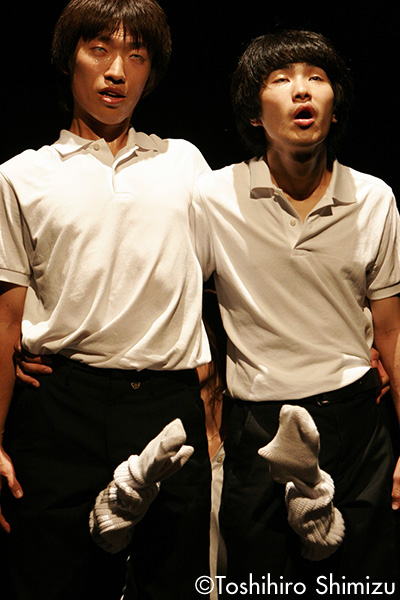
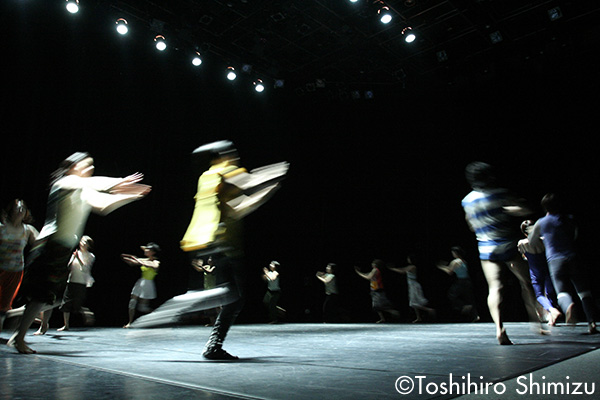
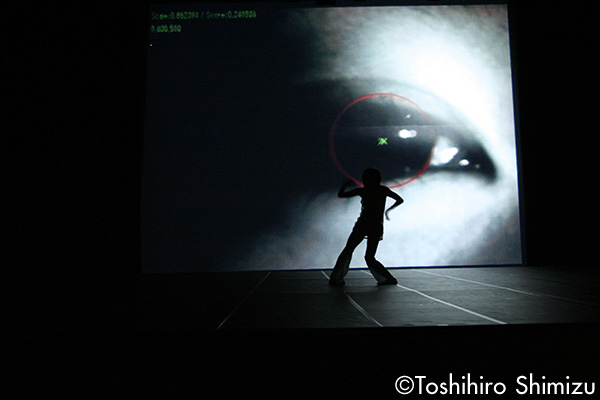
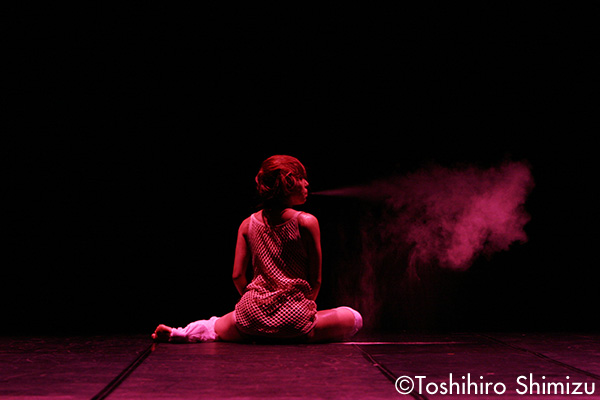
AI HALL’s “Take a chance project”
Motto Darwin
Composed and directed by Tadasu Takamine
(Sep. 2005 at Itami AI HALL theater)
Photo: Toshihiro Shimizu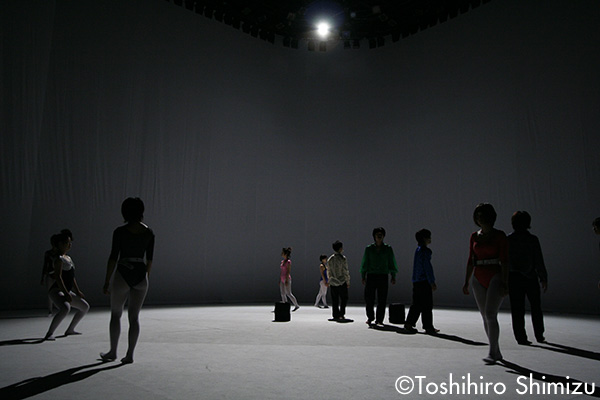
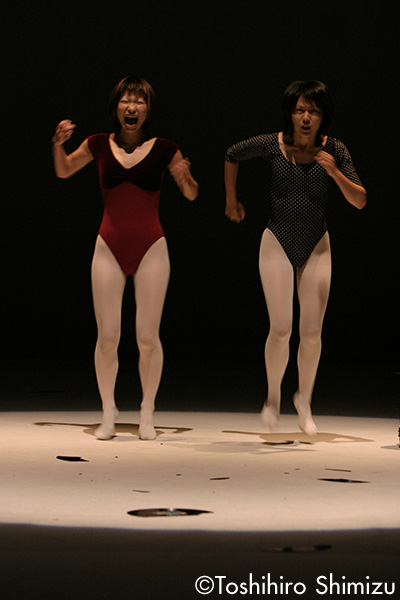
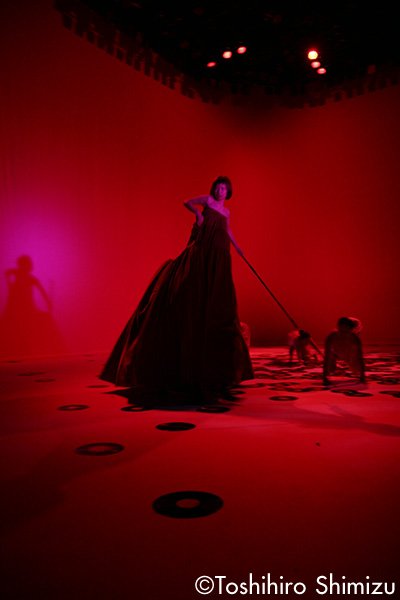
AI HALL’s “Take a chance project”
Aromaroa Erogeroe
Composed and directed by Tadasu Takamine
(Sep. 2006 at Itami AI HALL theater)
Photo: Toshihiro Shimizu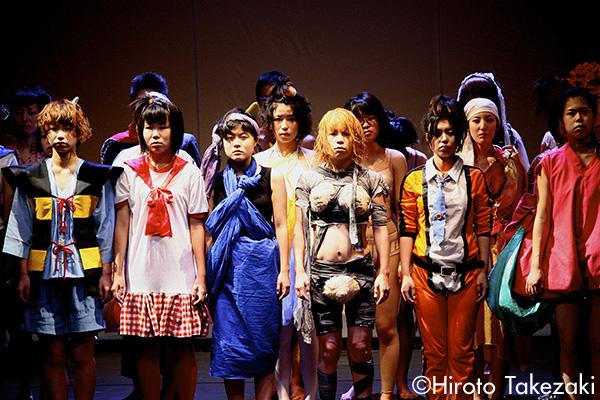
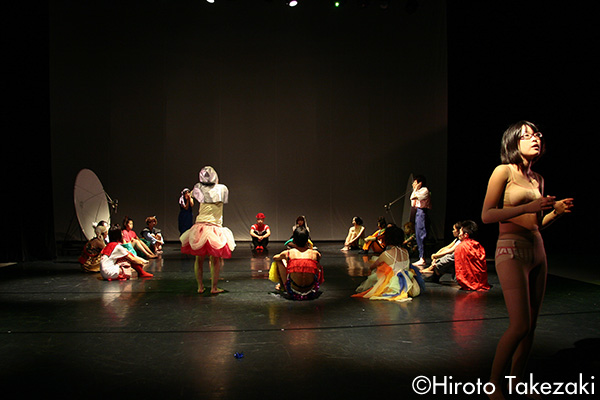
AI HALL and Tadasu Takamine’s workshop and performance project
Reversible dayo Jinsei ha
(Sep. 2007 at Itami AI HALL theater)
Photo: Hiroto Takezaki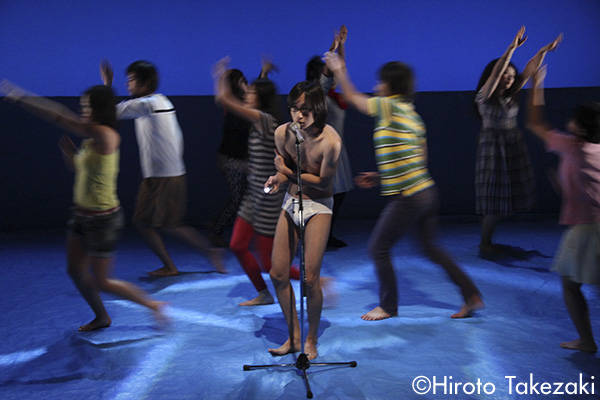
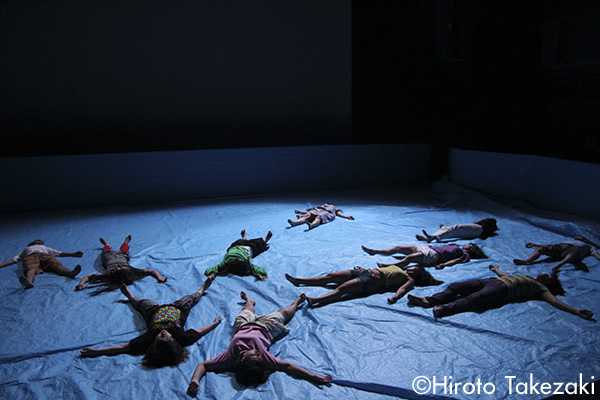
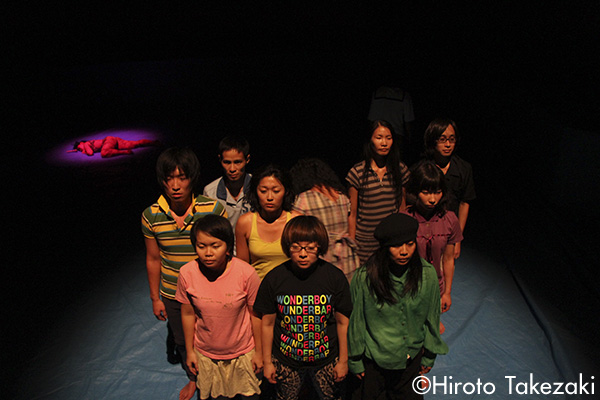
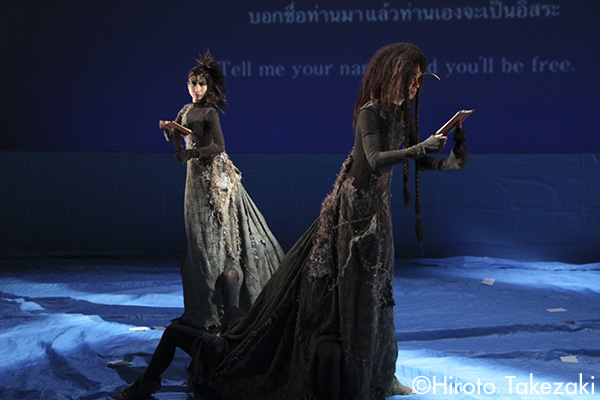
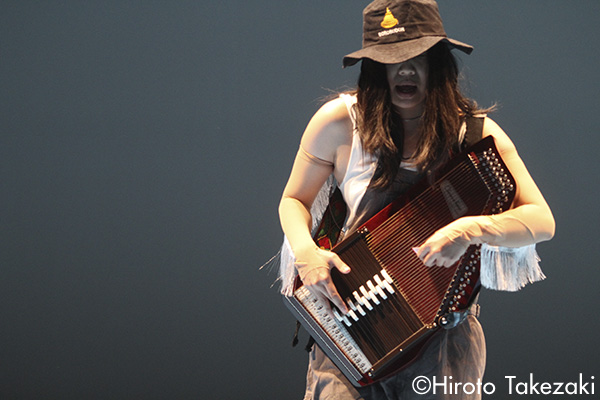
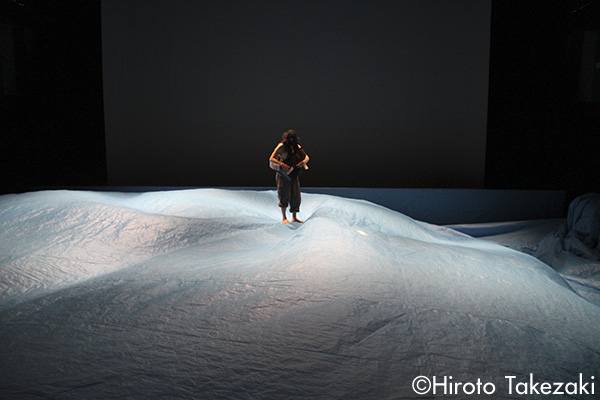
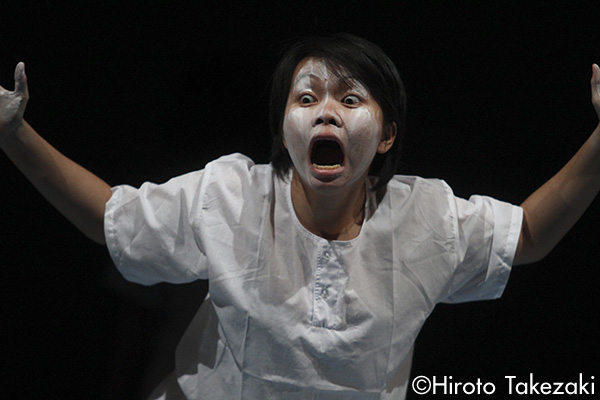
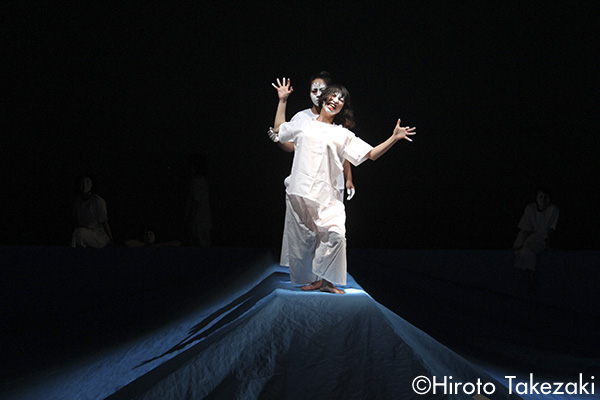

Melody♥Cup
(Feb. 2011 at Itami AI HALL theater)
Photo: Hiroto TakezakiRelated Tags
Tadasu Takamine
Committing to society - the bricolage theater of Tadasu Takamine
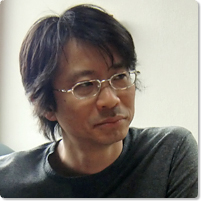
Tadasu Takamine
After beginning his career as a performer with the pioneering multimedia performance group dumb type, Tadasu Takamine is now active internationally as a contemporary artist. As in creations such as the video work Kimura san , about a person who assists in sexual care for a seriously disabled male victim of the Morinaga poisoned milk extortion incident, Takamine has created a series of works that use video, installation, performance and other media to depicts the processes of dealing others and society as a whole. In recent years he has expanded his activities to stage art design, and since 2005 Takamine has opened up new ground by creating stage works through workshops in a bricolage style, bringing together a patchwork of elements. Of particular note is his work was Melody♥Cup that premiered in 2009 as a production of AI Hall (Itami city, Hyogo Pref.) bringing together Thai and Japanese participants in a stimulating mix of art, music, performance, video, reality and fiction that came together with a great deal of humor.
http://takaminet.com/
Interviewer: Reiko Shiga [contemporary dance producer]

